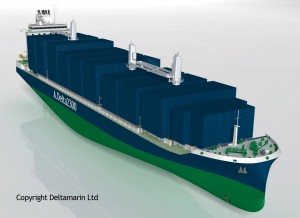Deltamarin is proud to introduce the first state-of-the-art container vessel of its series, the A.Delta2300. This new design is based on extensive research and development work to establish the best-in-class design in terms of cargo capacity, flexibility and fuel economy. It provides a flexible platform for a whole series of designs, which can be adapted to various customers’ requirements as a result of several optional feature studies.
The development work has been supported by AVIC Weihai Shipyard in terms of construction friendliness, and has been reviewed and commented on by DNV GL considering the application of the latest rules and industry practices. Deltamarin and AVIC Weihai Shipyard are both members of the AVIC Group, which is ranked among the Fortune Global 500 corporations. “The overall efficiency and flexibility of this container vessel design provides the owners and operators with a solution for future transportation needs,” explains Mr Vesa Hamarila, Sales Director of Deltamarin Ltd.
Increased cargo carrying capacity
The A.Delta2300 provides a container capacity of 2,322 TEU in five cargo holds and on deck. The increased cargo hold breadth improves stability in the fully laden condition. Together with the ballast-free approach, this results in an increased utilisation rate of about 73% (1,700 TEU) of nominal container intake in the homogeneous loading condition at scantling draught carrying a 14t TEU container. Furthermore, intake can be optimised to a specific cargo profile and even further improved by considering route-specific loading.
Flexibility
The high flexibility of the A.Delta2300 allows pallet-wide container stowage as well as three tiers of high cube containers in the cargo hold without losing container slots. Additionally, a high number of reefer plugs allows smart stowage and the reduction of unnecessary container movements. These features provide efficient and fluent stowage, which reduces time and costs.
Excellent fuel efficiency
Extensive effort has been focused on the A.Delta2300 hull form development to ensure low resistance combined with high propulsion efficiency. This included dozens of CFD calculations and three series of model tests at the Hamburg Ship Model Basin (HSVA). As a result, the vessel requires only low power at the design speed compared to present reference designs.
The daily main engine fuel oil consumption is decreased to 42 t/day at a 19-knot service speed resulting in superior fuel efficiency of 0.033 t/TEU/day. A strikingly low deadweight per TEU ratio of less than 16 DWT/14t TEU is thus achieved, which is commonly gained only in larger container ships. This efficiency decreases the EEDI (Energy Efficiency Design Index) value to approximately 37% below the IMO reference line complying with Phase 3, which enters into force in 2025.
Optional features for customisation
Optional features of the A.Delta2300 container feeder include LNG readiness, a flexible number of reefer plugs, shaft generator PTO/PTI, scrubber/SCR implementation and gearless design as well as several ice classes. Furthermore, stretched derivative designs are available, the A.Delta2500 and A.Delta2600.
Main Particulars A.Delta2300
| Length overall | 188.60 m |
| Breadth | 30.95 m |
| Draught, design | 8.75 m |
| Draught, scantling | 10.00 m |
| Capacity | 2,322 TEU |
| Capacity at 14 t/TEU | 1,700 TEU |
| Reefer plugs | 500 |
| Deadweight at 10.0 m | 26,580 t |
| M.E. FOC | 42 t/day |
| Service speed (15% s.m.) | 19.0 kn |
For more information please contact

Senior Advisor
Tel. +358 9 4788 4445
Mobile +358 40 5927 463
vesa.hamarila@deltamarin.com
Read more about Deltamarin’s container vessel designs here.







The daily main engine fuel oil consumption is decreased to 42 t/day at a 19-knot service speed resulting in superior fuel efficiency of 0.033 t/TEU/day.
Hi,
Is the fuel consumption and speed based on design draught or scantling draught?
Regards,
Pall
Dear Pall,
Thank you for your question.
The fuel consumption and speed are based on design draught.
Kind regards
Vesa Hamarila
1. Superstructure/Accommodation is provided for how many crew members?
2. Any Class Notation for bridge visibility? Wheelhouse design seems to be very traditional, thus, very difficult to satisfy Rules and Regulations. Please, comment!
Best regards,
Mario
Dear Mario,
1. The vessel accommodates 25 crew members and additionally 6 for Suez canal.
2. The bridge visibility is checked and fulfilled according to IMO as well as Panama visibility regulations. Initial class notation is NAV or NAV-INS, but of course the bridge design can be customised to the clients requirements and therefore class notation is adaptable.
Best regards
Vesa Hamarila